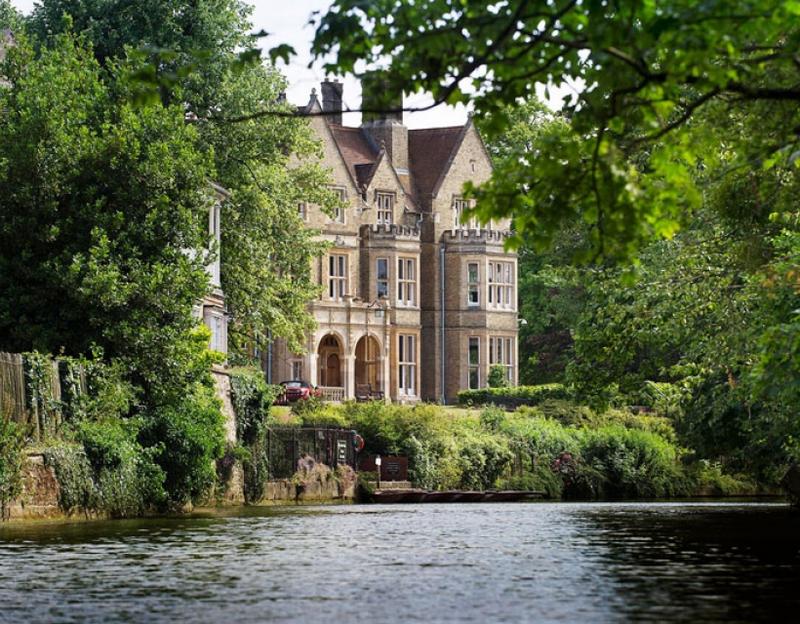The Architecture of the Women's Colleges
Professor William Whyte

The earliest colleges in Oxford were essentially monastic in inspiration. All-male enclaves, their statutes assumed that the scholars and their servants would be men, and forbade women from even passing through the front gate. At New College, in 1379, the single exception was a washerwoman ‘of such age and general appearance no sexual misdemeanour was likely to arise.’1
That colleges were places for men – and only men – remained such a universal belief that the very same restriction and exactly the same phrase was used in institutions founded by women. In 1610, Dorothy Wadham insisted that her new foundation would be populated entirely by men, with no women allowed on site apart from an elderly washerwoman.
Of course, real life is rarely a respecter of rules. Women did come into colleges: as servants, as guests, and – from the Reformation onwards – as the wives of college heads. But they were exceptions and sometimes problematic ones at that. At St John’s and at Trinity, the difficulty of accommodating the President’s wife in chapel was solved by the creation of a separate, closed box in which she was confined. Shut away from the men, she could participate (up to a point) without ever disturbing the masculine environment of the place.
As this suggests, gender had architectural consequences. By the late-nineteenth century, when the women began to establish their own equivalents, the college – with its quadrangles, staircases, halls, and chapels – had come to be seen and experienced as deeply conservative and inherently masculine Even the pervasive Gothic style of so many foundations seemed significant, with the Oxford Magazine in 1871 evoking the city’s ‘mellow old Colleges, standing as they ever did and will – staunch old Tories.’2
The question of how to house a college for woman was answered in two quite distinct ways in Cambridge. At Girton, from 1869, a great Gothic edifice was erected, with a grand gate tower, an imposing hall, and impressive chapel. Intended to demonstrate that women’s education could be the equivalent of men’s, its students were each housed in two-room ‘sets’, with sleeping accommodation separate from a larger study, just like the traditional model in the older colleges.
At Newnham, by contrast, the college was designed very differently. Its architecture was deliberately domestic, with students housed in a series of houses. Instead of a formal quadrangle, the buildings were set round a picturesque garden. The style was equally distinctive, with red-brick, terracotta, white-painted wooden balustrades, and pretty seventeenth-century shaped gables. This represented a conscious rejection of traditional, Gothic forms – as did the nondenominational foundation’s decision not to build a separate chapel. The college also chose to abandon the older idea of the undergraduate ‘set’, housing its students instead in cheaper, single study-bedrooms.
The first two colleges at Oxford echoed domestic, Renaissance Newnham far more than the institutional Gothic of Girton. In part, this was the result of expedience. When Lady Margaret Hall was founded in 1878, it simply took on the lease of a house in Norham Gardens. Indeed, when it sought to expand into a neighbouring property, the landlord insisted that any link between the two buildings should not only be temporary but also look temporary. The landlord in question – St John’s College, as it happens – evidently feared that the experiment of women’s higher education was likely not to last.
Somerville started its existence in another house in 1879. Two years later, it started to build an extension: one that echoed the large windows, fancy gables, and Renaissance of style of Newnham. It was small-scale and also undeniably domestic, with the plans even specifying the need for diminutive ‘flower-balconies’ beneath the windows.
Yet it was not expedience alone that led to these design decisions. In part, as other historians have argued, the women’s colleges were seeking to conceal the change they heralded behind more traditional – and safely feminine – forms. Less a house than a Trojan Horse, the domestic feel of each of these new homes was a way of deflecting criticism.
Some design decisions also reflected very real anxieties on the part of their founders about the conditions in which women’s education could flourish. The smaller rooms and the abandonment of the undergraduate ‘set’ were a product of economic considerations. They were cheaper to build and, just as importantly, cheaper to rent. At a time in which demand for the higher education of women was uncertain, cost was a central consideration. Questions of health also had consequences. In the men’s colleges, rooms were grouped on staircases, meaning that trips to the communal lavatories or bathhouses could involve a run though the rain in little more than a dressing gown. This was thought improper – even dangerous – for women, and so their rooms were linked together by ever-longer corridors.
Above all, the women’s colleges were engaged in the invention of tradition. They were reworking the older idea of the college. They were also updating it. The neo-Renaissance style embraced at Somerville and LMH was widely understood at the time as progressive. It linked them to reforms in Oxford and beyond. Moreover, it gave them a common architectural language so that they came to resemble each other much more than they imitated the older, men’s foundations.
This shared architectural sensibility was encouraged by the fact that the women’s colleges were located outside the city centre. Indeed, as the men’s colleges expanded at the heart of Oxford, expelling shops and family homes, it became ever more masculine, while the suburbs were seen as increasingly feminine. One woman recalled that her attempt to buy a map of the city in the 1890s was frustrated by a shopkeeper who declared that she would not need one of central Oxford. As a lady, he assumed, she only required a guide to the outskirts of the place. The foundation of St Hugh’s in North Oxford in 1886 and St Hilda’s across the Isis in 1893 confirmed this impression and also encouraged the development of more domestic architectural forms.
With time, these colleges grew in size and their sites became more formal – more obviously collegiate – in plan. From the beginning of the 1890s they gained quadrangles, grand halls, imposing entrances, and, at LMH and Somerville, they even acquired stately chapel buildings. But the decisions made at their foundations can be discerned today. The ‘temporary’ link erected at Lady Margaret Hall remains in place. Still more, the redbrick and terracotta, the long corridors, the study bedrooms, the informal gardens: these all evoke the pioneering attempt made to create women’s colleges in a university which had, for so long, seen the very idea as a contradiction in terms.
[1] Alfred Cobban, English University Life In The Middle Ages (London, 1999), p. 137.
[2] Quoted in William Whyte, Oxford Jackson: Architecture, Education, Status, and Style 1835-1924 (Oxford, 2006), p. 89.





